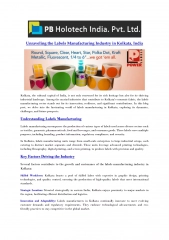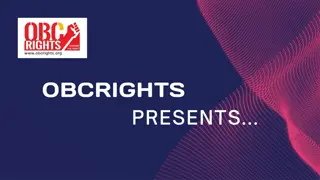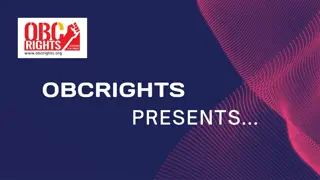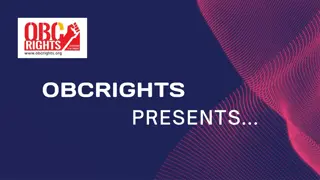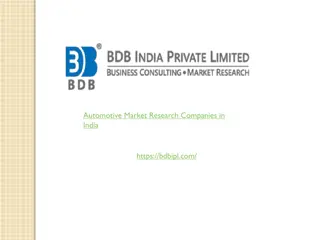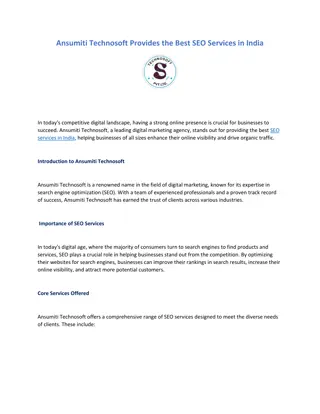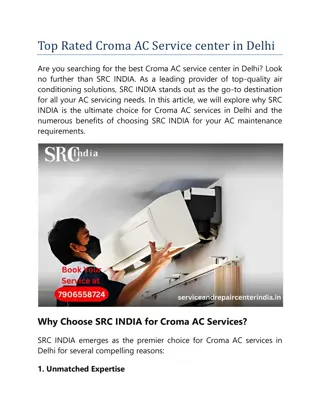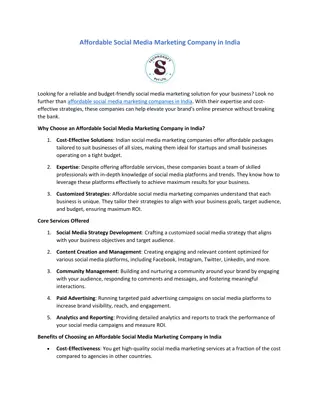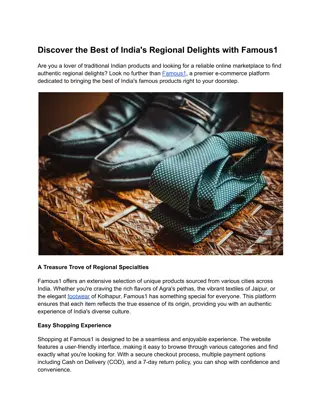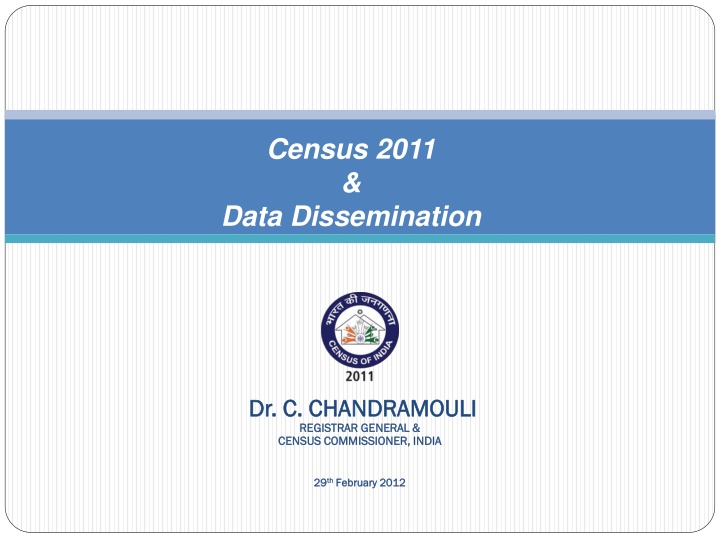
Insights into Census 2011 Data Dissemination and Challenges Faced
Explore the process of Census 2011 data dissemination, challenges, and the diverse characteristics of the vast Indian population. Learn about the extensive use of GIS/ICT, the complex logistics involved, and the significant manpower deployed. Discover the legal backing provided by the Census Act 1948 and the multi-ethnic challenges faced during this monumental task. Gain insights into the house-to-house canvassing method, image-based recognition, and the manual completion of unrecognized characters. Dive into the intricate details of Census 2011, reflecting the fascinating diversity and sheer scale of India's demographic landscape.
Download Presentation

Please find below an Image/Link to download the presentation.
The content on the website is provided AS IS for your information and personal use only. It may not be sold, licensed, or shared on other websites without obtaining consent from the author. If you encounter any issues during the download, it is possible that the publisher has removed the file from their server.
You are allowed to download the files provided on this website for personal or commercial use, subject to the condition that they are used lawfully. All files are the property of their respective owners.
The content on the website is provided AS IS for your information and personal use only. It may not be sold, licensed, or shared on other websites without obtaining consent from the author.
E N D
Presentation Transcript
Census 2011 & Data Dissemination Dr. C. CHANDRAMOULI Dr. C. CHANDRAMOULI REGISTRAR GENERAL & REGISTRAR GENERAL & CENSUS COMMISSIONER, INDIA CENSUS COMMISSIONER, INDIA 29 29th thFebruary 2012 February 2012
Census of India 2011 Census of India 2011 2
Features of Census 2011 Features of Census 2011 Legal Backing Legal Backing Census Act 1948 Census Act 1948 Paper Based Paper Based - - Extended de facto canvasser method Extended de facto canvasser method Extensive use of GIS/ICT in pre Census and Census Extensive use of GIS/ICT in pre Census and Census activities activities Highly manpower intensive Highly manpower intensive- - 2.7 million persons deployed deployed 2.7 million persons Complex Logistics Complex Logistics ICR Technology for data processing ICR Technology for data processing 3
Challenges Diverse & Vast 2.4% of worlds surface area 2.4% of worlds surface area 1.2 1.2 bn bn population population 2 2nd largest in the world Large Large Population Population ndlargest in the world 0.6 million villages 0.6 million villages 7935 Towns 7935 Towns Multi Multi- -level level 4,635 ethnic groups 4,635 ethnic groups 80,000 Segments, Synonyms and Titles 80,000 Segments, Synonyms and Titles Multi Multi- -Ethnic Ethnic Challenges
Challenges Diverse & Vast 655 religions and other persuasions 655 religions and other persuasions 18 languages (training); 16 languages (canvassing); 18 languages (training); 16 languages (canvassing); 6661 mother tongues 6661 mother tongues Multi Multi- -cultural cultural Nomads, Homeless, Forest/Island Dwellers Nomads, Homeless, Forest/Island Dwellers Infants, Elderly women, Disabled Infants, Elderly women, Disabled Difficult Difficult people people Disturbed civil conditions Disturbed civil conditions Inaccessible terrain Inaccessible terrain Difficult Difficult Areas Areas
Census 2011 Process Census 2011 Process House to house House to house canvassing canvassing (extended de facto) (extended de facto) Image based Image based Recognition (ICR) Recognition (ICR) Scanning Scanning Data Data Database/ Database/ Tabulation Tabulation Manual completion of Manual completion of unrecognized characters unrecognized characters Image validation Image validation Dissemination Dissemination
Census 2011 Data Highlights
Total Population (in Crore) 2001 2011 Difference India 102.9 121.0 18.1 Rural 74.3 83.3 9.0 Urban 28.6 37.7 9.1 For the first time since Independence, the absolute increase in population is more in urban areas that in rural areas Rural Urban distribution: 68.84% & 31.16% Level of urbanization increased from 27.81% in 2001 Census to 31.16% in 2011 Census The proportion of rural population declined from 72.19% to 68.84%
Trends in Rural Urban Distribution of Population - India (in %) (1901, 1951, 2011) 1901 CENSUS India 89.2 2011 CENSUS India 10.8 68.8 31.2 1951 CENSUS India 82.7 17.3 Rural Urban
Percentage share of Urban Population in Total Population India, 2001 & 2011 INDIA 2001 INDIA 2011
Growth Rate of Population (in %) 1991-2001 2001-2011 Difference India 21.5 17.6 -3.9 Rural 18.1 12.2 -5.9 Urban 31.5 31.8 +0.3 The slowing down of the overall growth rate of population is due to the sharp decline in the growth rate in rural areas, while the growth rate in urban areas remains almost the same.
Growth Rate of Population (in %) 1991-2001 2001-2011 Difference EAG 25.0 20.9 -4.1 Rural 23.5 18.7 -4.8 Urban 31.6 29.9 -1.7 Non EAG 18.9 15.0 -3.9 Rural 13.2 5.7 -7.5 Urban 31.5 32.7 +1.2 Though the growth rate of population in rural areas of EAG States is nearly 3 times that in rural areas in non EAG States, it is for the first time that significant fall of growth rate is seen in the rural areas of EAG States
Growth Rates (Rural) India, EAG & Non-EAG States 25 General decline in Rural Growth Rate among all the three categories during the last decade 2001-11 Whereas Non-EAG States have shown decline in growth since 1971-81, the EAG States have declined only during the last decade. The Growth in Rural Areas in Non-EAG States during 2001-11 has sharply declined to 5.71%. 23.47 22.74 23 22.40 21.88 21.86 21 20.31 20.04 20.64 20.85 19.32 18.72 India 19 18.09 19.26 18.47 17 17.98 EAG States 15 13 12.18 13.22 Non- EAG States 11 9 7 5.73 5 1951-1961 1961-1971 1971-1981 1981-1991 1991-2001 2001-2011 EAG States are Rajasthan, Uttar Pradesh, Uttarakhand, Bihar, Jharkhand, Madhya Pradesh, Chhattisgarh and Orissa Source: Census 2011 Provisional Population Totals - India
Sex Ratio 2001 2011 Difference Overall India 933 940 +7 Rural 946 947 +1 Urban 900 926 +26 0-6 years India 927 914 -13 Rural 934 919 -15 Urban 906 902 -4 The improvement in overall sex ratio is largely in urban areas Though the Urban Child sex ratio is far worse than in the rural areas, the fall in Child sex ratio in rural areas is around 4 times that in urban areas. In fact the decline is more gradual in urban areas. There is a decline of 8.9 million children in Rural areas, while in Urban areas has shown increase of 3.9 million.
Literacy Rates (in %) 2001 2011 Difference Overall India 64.8 74.0 +9.2 Rural 58.7 68.9 +10.2 Urban 79.9 85.0 +5.1 The improvement in literacy rate in rural area is two times that in urban areas The rural urban literacy gap which was 21.2 percentage points in 2001, has come down to 16.1 percentage points in 2011
Literacy Rate - Male/Female (in %) 2001 2011 Difference Males India 75.3 82.1 +6.8 Rural 70.7 78.6 +7.9 Urban 86.3 89.7 +3.4 Females India 53.7 65.5 +11.8 Rural 46.1 58.8 +12.7 Urban 72.9 79.9 +7.0 Improvement in female literacy is more than males in both rural and urban areas The gender gap in literacy has come down from 24.6 in 2001 to 19.8 in 2011 in rural areas and from 13.4 in 2001 to 9.8 in 2011 in urban areas
Literacy Rate : Rural Census 2011 Pace of increase in Female Literacy Rate is perceptibly higher in Rural areas. 90 78.57 80 70.70 Males 70 It has increased from 46.13% in 2001 to 58.75% in 2011 58.75 56.96 60 48.26 46.13 50 42.98 37.49 40 Females 30.17 26.91 26.12 30 26.49 24.57 Gender gap in Literacy Rate has narrowed down considerably over the Censuses but continue to be high (19.81). 19.82 26.79 20 21.35 10 16.86 Male-Female gap in literacy rate 11.00 Percent 0 1961 1971 1981 1991 2001 2011 Census year This gap is largest in Rajasthan (31.2 points) Source: Census 2011 Provisional Population Totals - India
Literacy Rate: Urban Census 2011 There has been a consistent increase in both Male & Female Literacy Rate in Urban areas 100 89.67 86.27 90 81.09 78.56 74.64 Males 80 70.77 79.92 70 72.86 60 64.05 58.07 50 Females 52.54 40 43.75 27.02 The steady increase in the Female Literacy Rate has reduced the gender gap significantly 30 22.10 20.49 17.04 20 13.41 9.75 Percent Male-Female gap in literacy rate 10 0 1961 1971 1981 1991 2001 2011 Census year Source: Census 2011 Provisional Population Totals - India
Census 2011 -Data Dissemination Development of CensusInfo Dashboard Based on Dev Info platform 6.0 Provisional results from Census 2011 released using Census Dashboard
CensusInfo Dashboard on the Web
CensusInfo State Comparisons
Area Profile
Thank You Registrar General and Census Commissioner, India, Registrar General and Census Commissioner, India, 2 A Mansingh Road, New Delhi 110011, India Phone: +91-11-24105383 Fax: +91-11-23383145 E mail: rgi.rgi@nic.in Website: http://www.censusindia.gov.in



